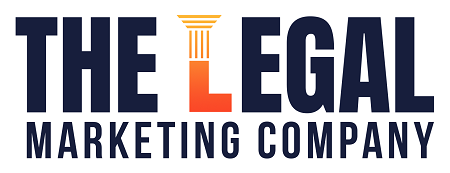In digital marketing, a Call to Action (CTA) is a prompt that encourages website visitors to take a specific action. A CTA can be a button, text, or image inviting visitors to sign up for a newsletter, download a free guide, or request a consultation.
CTAs are essential for legal websites as they help visitors navigate the website, find relevant information, and contact the law firm. A well-designed CTA can make a significant difference in the conversion rates of a website, turning a visitor into a potential client.
Here, you can learn more about the importance of CTAs on legal websites. Our law firm marketing company specializes in creating compelling CTAs. We honestly take pride in offering customized solutions for our clients.
Different Types of Calls to Action for Legal Websites
Various types of CTAs can be used on a legal website, including button CTAs, text CTAs, and image CTAs. Each type of CTA has unique features and benefits, and choosing the right type of CTA is critical to the website’s success.
Button CTA
A button CTA is a prominent and clickable button placed on a webpage to encourage the visitor to take a specific action. The design and placement of a button CTA play a crucial role in attracting the website visitor’s attention. Examples of button CTAs that can be used on a legal website include:
- “Contact Us”
- “Schedule a Consultation”
- “Download Now”
- “Subscribe”
Text CTA
A text CTA is a short phrase or sentence hyperlinked to a specific landing page. It can be placed within the content of a webpage or at the end of a blog post. Text CTAs are essential as they give visitors a clear direction on what action to take next. Examples of text CTAs that can be used on a legal website include:
- “Read More About Our Services”
- “Learn More About Our Firm”
- “Contact Us to Discuss Your Case”
- “Find Out How We Can Help You Today”
Image Call to Action
An image CTA is a visual prompt encouraging website visitors to take a specific action. It can be a clickable image, icon, or graphic placed on a webpage. Image CTAs are eye-catching and can direct visitors’ attention to a specific area of the webpage. Examples of image CTAs that can be used on a legal website include:
- A banner image with a CTA button
- An infographic that encourages visitors to learn more about a specific legal issue
- A graphic that promotes a free consultation or eBook
- A video thumbnail that encourages visitors to watch a lawyer’s introduction video
It is essential to choose the type of CTA that best suits the objective of the webpage and provides clear instructions to the visitor. Combining all three types of CTAs can effectively lead visitors toward the desired action, whether booking a consultation or downloading a free guide.
Elements of an Effective Call to Action on a Legal Website
Merely adding a CTA to a website is insufficient to ensure its effectiveness. Several essential elements must be considered to create an effective CTA on a legal website.
Clear and Concise Language
The language used in a CTA should be simple, clear, and concise. Visitors should be able to understand what action they are being asked to take and why it’s essential. Avoid using technical legal jargon that can confuse visitors and make the CTA less effective.
Placement of CTA
The placement of a CTA is crucial to its effectiveness. It should be prominently displayed and easy to find. Placing the CTA above the fold or where it’s easily noticeable can increase the chances of visitors clicking on it. It’s also important to consider the webpage’s flow and ensure that the CTA is located logically following the content.
Use of Colors and Design
The colors and design of a CTA can play a significant role in attracting the visitor’s attention. The color of the CTA should contrast with the rest of the webpage, making it stand out. It’s also essential to consider the overall design of the CTA, making sure it’s visually appealing and consistent with the website’s branding.
Value Proposition
A value proposition explains the benefit the visitor will receive by taking the desired action. It should be clear and concise and highlight the value the visitor will receive by clicking on the CTA. For example, “Schedule a Consultation Today and Get the Legal Advice You Need.”
Urgency
Creating a sense of urgency can be a powerful motivator for visitors to take action. It can be achieved using phrases such as “Limited Time Offer” or “Act Now.” Adding a deadline or a countdown timer can also create a sense of urgency and increase the chances of visitors clicking on the CTA.
Best Practices for Creating Call to Action on a Lawyer Website
A call to action (CTA) is a critical element of any legal website as it helps convert visitors into potential clients. However, creating an effective CTA can be a challenging task. In this blog post, we will discuss the best practices for creating a CTA on a legal website that is aligned with the website’s objective, uses action-oriented language, is optimized through A/B testing, and incorporates contact forms.
Align CTA with the Website’s Objective
The CTA should align with the website’s primary objective, whether to book a consultation, subscribe to a newsletter, or download a free guide. The language used in the CTA should be clear and concise, explaining precisely what the visitor will get by taking the desired action.
Use Action-Oriented Language
The language used in the CTA should be action-oriented, encouraging visitors to take the desired action. For example, “Schedule a Consultation Now” is more effective than “Learn More About Our Services.” The language should also create a sense of urgency, encouraging visitors to act immediately.
A/B Testing
A/B testing involves testing different CTA versions to determine which is more effective. This can include testing different colors, designs, placement, and language. A/B testing can provide valuable insights into what works best for your website’s audience and help improve the overall effectiveness of the CTA.
Incorporating Contact Forms
Incorporating a contact form into the CTA can make it easier for visitors to take action. Contact forms can be used to collect visitor’s information and integrated with a customer relationship management (CRM) system to streamline following up with potential clients.
Common Mistakes to Avoid While Creating Call to Action on a Legal Website
While creating a call to action (CTA) on a legal website, it’s essential to avoid common mistakes that can negatively impact the effectiveness of the CTA.
Using Ambiguous Language
Using ambiguous language in the CTA can confuse visitors and make them less likely to take the desired action. The language should be clear and concise, explaining precisely what the visitor will get by taking the desired action.
Cluttering the CTA
Cluttering the CTA with too much information can make it difficult for visitors to understand what action they should take. The CTA should be prominently displayed and contain only the essential information necessary to encourage visitors to take the desired action.
Using Inappropriate Colors and Design
The colors and design used in the CTA should be consistent with the website’s branding and create a contrast that makes the CTA stand out. Using inappropriate colors and designs can make the CTA less effective and make visitors less likely to click.
Overcomplicating the Process
Overcomplicating the process of taking the desired action can make visitors less likely to complete the process. The process should be simple and straightforward, making it easy for visitors to take the desired action.
Avoiding common mistakes while creating a CTA on a legal website is essential to maximize its effectiveness. By following these tips, law firms can increase their website’s conversion rates and attract potential clients.
At The Legal Marketing Company, We Can Help You Achieve Marketing
Creating an effective call to action (CTA) on a legal website is essential to attract and convert potential clients.
By carefully considering the different types of CTAs, such as buttons, text, and images, law firms can design and place CTAs that best suit their website’s objectives.
Additionally, by incorporating elements such as clear and concise language, strategic placement, the use of colors and design, a value proposition, and urgency, law firms can ensure that their CTAs are effective and optimized for success.
At The Legal Marketing Company, we understand the importance of effective CTAs and can help law firms achieve marketing success by designing and implementing them on their websites.
Our team of experts can work with law firms to create customized and tailored solutions that align with their specific objectives and needs. We can also provide valuable insights and strategies to help law firms optimize their CTAs and improve their conversion rates.
Whether creating a new website or optimizing an existing one, The Legal Marketing Company is here to help law firms achieve marketing success. Contact us today to learn how we can help you grow your practice and attract potential clients.
The Legal Marketing Company is a full-service marketing agency for law firms. If you have questions about intake or marketing you law firm please give us a call. 904-385-9124.












